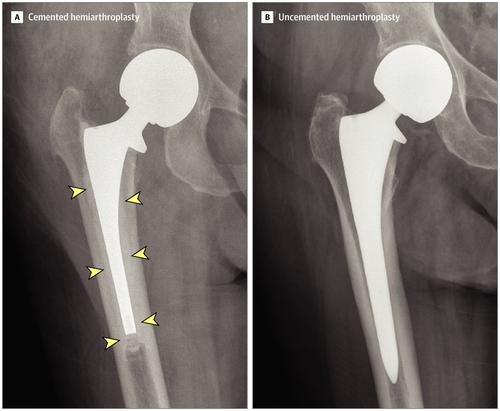Our official English website, www.x-mol.net, welcomes your feedback! (Note: you will need to create a separate account there.)
Association Between Uncemented vs Cemented Hemiarthroplasty and Revision Surgery Among Patients With Hip Fracture
JAMA ( IF 120.7 ) Pub Date : 2020-03-17 , DOI: 10.1001/jama.2020.1067 Kanu Okike 1 , Priscilla H Chan 2 , Heather A Prentice 2 , Elizabeth W Paxton 2 , Robert A Burri 3
JAMA ( IF 120.7 ) Pub Date : 2020-03-17 , DOI: 10.1001/jama.2020.1067 Kanu Okike 1 , Priscilla H Chan 2 , Heather A Prentice 2 , Elizabeth W Paxton 2 , Robert A Burri 3
Affiliation

|
Importance
Consensus guidelines and systematic reviews have suggested that cemented fixation is more effective than uncemented fixation in hemiarthroplasty for displaced femoral neck fractures. Given that these recommendations are based on research performed outside the United States, it is uncertain whether these findings also reflect the US experience. Objective
To compare the outcomes associated with cemented vs uncemented hemiarthroplasty in a large US integrated health care system. Design, Setting, and Participants
Retrospective cohort study of 12 491 patients aged 60 years and older who underwent hemiarthroplasty treatment of a hip fracture between 2009 and 2017 at 1 of the 36 hospitals owned by Kaiser Permanente, a large US health maintenance organization. Patients were followed up until membership termination, death, or the study end date of December 31, 2017. Exposures
Hemiarthroplasty (prosthetic replacement of the femoral head) fixation via bony growth into a porous-coated implant (uncemented) or with cement. Main Outcomes and Measures
The primary outcome measure was aseptic revision, defined as any reoperation performed after the index procedure involving exchange of the existing implant for reasons other than infection. Secondary outcomes were mortality (in-hospital, postdischarge, and overall), 90-day medical complications, 90-day emergency department visits, and 90-day unplanned readmissions. Results
Among 12 491 patients in the study cohort who underwent hemiarthroplasty for hip fracture (median age, 83 years; 8660 women [69.3%]), 6042 (48.4%) had undergone uncemented fixation and 6449 (51.6%) had undergone cemented fixation, and the median length of follow-up was 3.8 years. In the multivariable regression analysis controlling for confounders, uncemented fixation was associated with a significantly higher risk of aseptic revision (cumulative incidence at 1 year after operation, 3.0% vs 1.3%; absolute difference, 1.7% [95% CI, 1.1%-2.2%]; hazard ratio [HR], 1.77 [95% CI, 1.43-2.19]; P < .001). Of the 6 prespecified secondary end points, none showed a statistically significant difference between groups, including in-hospital mortality (1.7% for uncemented fixation vs 2.0% for cemented fixation; HR, 0.94 [95% CI, 0.73-1.21]; P = .61) and overall mortality (cumulative incidence at 1 year after operation: 20.0% for uncemented fixation vs 22.8% for cemented fixation; HR, 0.95 [95% CI, 0.90-1.01]; P = .08). Conclusions and Relevance
Among patients with hip fracture treated with hemiarthroplasty in a large US integrated health care system, uncemented fixation, compared with cemented fixation, was associated with a statistically significantly higher risk of aseptic revision. These findings suggest that US surgeons should consider cemented fixation in the hemiarthroplasty treatment of displaced femoral neck fractures in the absence of contraindications.
中文翻译:

髋部骨折患者非骨水泥与骨水泥半髋关节置换术与翻修手术的关系
重要性共识指南和系统评价表明,在移位股骨颈骨折的半关节置换术中,骨水泥固定比非骨水泥固定更有效。鉴于这些建议是基于在美国以外进行的研究,不确定这些发现是否也反映了美国的经验。目的比较在美国大型综合医疗保健系统中骨水泥与非骨水泥半髋关节置换术的相关结果。设计、设置和参与者回顾性队列研究对 2009 年至 2017 年间在美国大型健康维护组织 Kaiser Permanente 拥有的 36 家医院中的 1 家接受半关节置换术治疗髋部骨折的 12491 名 60 岁及以上患者进行了回顾性队列研究。随访患者直至会员终止、死亡、或研究结束日期为 2017 年 12 月 31 日。暴露半关节成形术(股骨头的假体置换)通过骨生长固定到多孔涂层植入物(非骨水泥)或水泥中。主要结果和测量 主要结果测量是无菌翻修,定义为在指数程序后进行的任何再手术,包括因感染以外的原因更换现有植入物。次要结局是死亡率(住院、出院后和总体)、90 天医疗并发症、90 天急诊就诊和 90 天计划外再入院。结果在研究队列中因髋部骨折接受半髋关节置换术的 12 491 例患者中(中位年龄 83 岁;8660 名女性 [69.3%]),其中 6042 例(48.4%)接受了非骨水泥固定,6449 例(51.6%)接受了骨水泥固定,中位随访时间为 3.8 年。在控制混杂因素的多变量回归分析中,非骨水泥固定与显着更高的无菌性翻修风险相关(术后 1 年的累积发生率,3.0% vs 1.3%;绝对差异,1.7% [95% CI,1.1%-2.2 %];风险比 [HR],1.77 [95% CI,1.43-2.19];P < .001)。在预先设定的 6 个次要终点中,包括住院死亡率(非骨水泥固定为 1.7%,骨水泥固定为 2.0%;HR,0.94 [95% CI,0.73-1.21];P = .61)和总死亡率(术后 1 年的累积发生率:非骨水泥固定 20.0% 和骨水泥固定 22.8%;HR,0.95 [95% CI,0.90-1.01];P = .08)。结论和相关性 在美国大型综合医疗保健系统中接受半髋关节置换术治疗的髋部骨折患者中,与骨水泥固定相比,非骨水泥固定与无菌性翻修风险显着增加相关。这些研究结果表明,在没有禁忌症的情况下,美国外科医生应考虑在移位股骨颈骨折的半关节置换术治疗中使用骨水泥固定。
更新日期:2020-03-17
中文翻译:

髋部骨折患者非骨水泥与骨水泥半髋关节置换术与翻修手术的关系
重要性共识指南和系统评价表明,在移位股骨颈骨折的半关节置换术中,骨水泥固定比非骨水泥固定更有效。鉴于这些建议是基于在美国以外进行的研究,不确定这些发现是否也反映了美国的经验。目的比较在美国大型综合医疗保健系统中骨水泥与非骨水泥半髋关节置换术的相关结果。设计、设置和参与者回顾性队列研究对 2009 年至 2017 年间在美国大型健康维护组织 Kaiser Permanente 拥有的 36 家医院中的 1 家接受半关节置换术治疗髋部骨折的 12491 名 60 岁及以上患者进行了回顾性队列研究。随访患者直至会员终止、死亡、或研究结束日期为 2017 年 12 月 31 日。暴露半关节成形术(股骨头的假体置换)通过骨生长固定到多孔涂层植入物(非骨水泥)或水泥中。主要结果和测量 主要结果测量是无菌翻修,定义为在指数程序后进行的任何再手术,包括因感染以外的原因更换现有植入物。次要结局是死亡率(住院、出院后和总体)、90 天医疗并发症、90 天急诊就诊和 90 天计划外再入院。结果在研究队列中因髋部骨折接受半髋关节置换术的 12 491 例患者中(中位年龄 83 岁;8660 名女性 [69.3%]),其中 6042 例(48.4%)接受了非骨水泥固定,6449 例(51.6%)接受了骨水泥固定,中位随访时间为 3.8 年。在控制混杂因素的多变量回归分析中,非骨水泥固定与显着更高的无菌性翻修风险相关(术后 1 年的累积发生率,3.0% vs 1.3%;绝对差异,1.7% [95% CI,1.1%-2.2 %];风险比 [HR],1.77 [95% CI,1.43-2.19];P < .001)。在预先设定的 6 个次要终点中,包括住院死亡率(非骨水泥固定为 1.7%,骨水泥固定为 2.0%;HR,0.94 [95% CI,0.73-1.21];P = .61)和总死亡率(术后 1 年的累积发生率:非骨水泥固定 20.0% 和骨水泥固定 22.8%;HR,0.95 [95% CI,0.90-1.01];P = .08)。结论和相关性 在美国大型综合医疗保健系统中接受半髋关节置换术治疗的髋部骨折患者中,与骨水泥固定相比,非骨水泥固定与无菌性翻修风险显着增加相关。这些研究结果表明,在没有禁忌症的情况下,美国外科医生应考虑在移位股骨颈骨折的半关节置换术治疗中使用骨水泥固定。



























 京公网安备 11010802027423号
京公网安备 11010802027423号